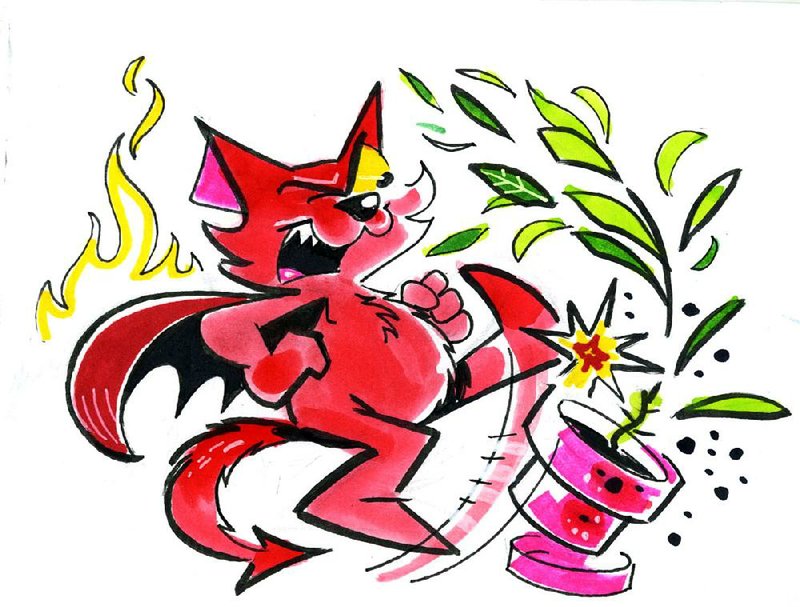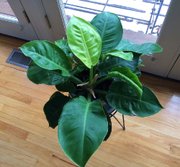Q Can you tell me a product-ive way to keep my house cats from wreaking havoc on my house plants? Every day when I come home from work, it seems there is potting soil on the floor and half of the plant is uprooted. They aren't eating the plants, but I think they may be trying to use the pots as litter boxes. I really want some houseplants.
A Cats like to scratch when they use your plants as a litter box. Try mulching the soil with something sharp or spiny, such as small pine cones or sweetgum balls. If you don't have access to either, you could place small sticks or toothpicks in the pots. This should be enough of a deterrent the cats will go elsewhere.
Q I have an amethyst wisteria plant that is about 5 years old. Starting in June each year the leaves turn yellow with brown spots and start to fall off. I am trying to cover my arbor. My dreams of having a lush, shady place for my hammock are turning into a nightmare. I've tried everything.
A Wisteria is one of those tough plants that we usually hear about when someone wants to slow down its growth habits versus losing it to diseases. The only disease I have seen it have with any regularity is powdery mildew, which this does not sound like. What is the drainage like around the arbor? Wisteria doesn't like wet feet. That being said, if you have the same problem this year, as soon as you see it, take a sample of the foliage to your local county extension office. They can get it to our disease diagnostic lab for a proper diagnosis, so we'll know what treatment it requires. If it is a common fungus that's coming back each year, a preventive spray may be called for, but first let's find out what it is.
Q I'm hoping you can tell me the name of this plant by looking at this photograph. I was given a small cutting about four years ago. It didn't grow much until about a year ago. Now it's producing lots of new leaves that are really large, which of course is what the mother plant looked like. I'm not sure whether it blossoms, but I hope it will.
A The plant is a type of shrubby philodendron, not one of the vining types. There are many cultivars and hybrids of philodendrons, but my guess would be philodendron "Imperial Green." These plants are grown for their glossy foliage. As with most philodendrons, they are pretty tough plants that rarely flower.
Q When is the best time to move hydrangeas? I think they are getting too much sun where they are planted. They bloomed well last year but they wilted most afternoons when the sunlight hit them. Aren't they really a shade plant?
A Big leaf hydrangeas (Hydrangea macrophylla) will do best where they get morning sun and afternoon shade. Direct sun in the hot afternoon will cause daily wilting in hot weather, but if planted in too much shade they will not bloom. The best time to move hydrangeas would be in the late winter to early spring, after the bulk of winter weather is over. Hydrangeas are quite susceptible to winter damage -- last year we had great blooms, but it was the first year in three that they escaped winter kill. Big leaf hydrangeas have their flower buds set when they go dormant in the fall. If low temperatures damage the upper parts of the plant, summer blooming is reduced. Move your hydrangeas in early to mid-March.
Q On the clay pots of my potted plants is a white substance on the outside at the top of the pot. Sometimes there's a ring farther down toward the middle. I see it more during the summer months when the pots are outside, but even some of my empty pots on the shelf have it. I have tried to wipe it off with alcohol, but it does not totally come off. How can I get rid of it and what is causing it? I use Miracle-Gro potting soil, and my plants grow well.
A The white substance you see on the outside of your clay pots is accumulated salt. This salt comes from the fertilizers you are using and leaches through the porous clay containers. The potting soil you are using is pre-mixed with fertilizer, but it could happen from any fertilizer used in clay containers. Soak the pots in a 10 percent diluted bleach and water bath, letting them sit for 30 minutes to an hour. Then rinse thoroughly. If you still see the white substance, scrub with a small brush and allow them to dry in the sunlight. It doesn't hurt the pots or the plants, but it's not the most aesthetically pleasing look. This cleaning of the containers also sterilizes them and gives you a clean start on the growing season.
Janet B. Carson is a horticulture specialist for the University of Arkansas Cooperative Extension Service. Write to her at 2301 S. University Ave., Little Rock, Ark. 72204 or email her at
jcarson@arkansasonline.com
HomeStyle on 01/21/2017

